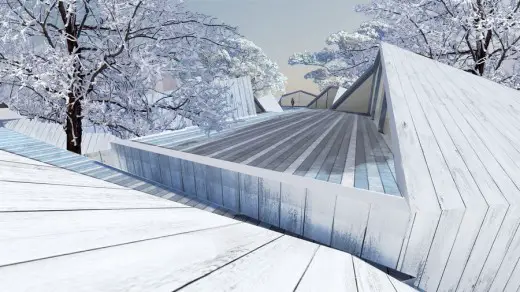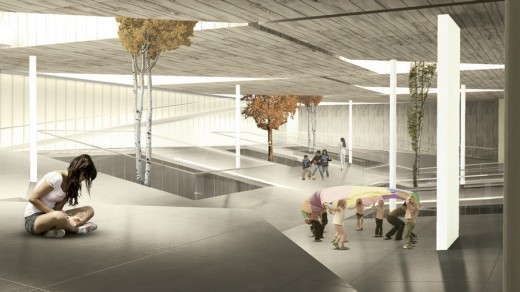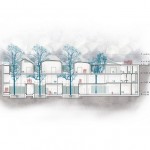Centre for Democracy, Seoul Building, Korean Building Design, Images, Architecture, Architect
Centre for Democracy
Historic Cultural Space in Korea – design by JDAP
23 Oct 2015
Centre for Democracy in Seoul
Design: JDAP Design – Architecture – Planning
Location: Seoul, South Korea
JDAP Design – Architecture – Planning has designed a new Centre for Democracy at Sejongdaero, Seoul as part of the Sejondgaero Historic Cultural Space Design Competition. Located at a newly vacated site in the heart of the historic city core, the Centre recognises and celebrates its building as a political act and seeks to nurture and commemorate the democratic processes that the site has been witness to in its modern history. Forming part of a larger vision of a subterranean public space that spans the Sejondaero, the building offers a park to the city, a memorial to its democratic struggles, a place of repose for its citizens and a place of learning for its children!
Beginnings
The site of the former National Tax Service Building at Taepyeong-ro is a potent opportunity to make manifest layers of History and Culture that lie dormant within the space of its neighbourhood. It becomes not only a local resource but a place over which citizens across the Republic of Korea may stake claim over and belonging to. As a central space for politics, and a space for the manifestation of the citizens’ will, the site situated within the heart of these processes and movements provides the ideal opportunity for memorialising and celebrating these realities.
The people of South Korea, have memorably experienced a process of democratic functioning that has been turbulent and yet evolutionary. Unlike many other nation states, the process of democracy experienced by the people here has been explicitly as a dynamic process and not as a static entity. Nowhere is this as evident as in the stages of the Six Republics that the country has evolved through. Situated within the heart of and ever-changing world city, the current site presents an ideal opportunity to celebrate and memorialise this process.
The new building at Taepyeong-ro gives the city of Seoul a valuable place, a memorable experience, and a symbolic gesture in the form of the new Centre For Democracy, Sejongdaero. The building is a container of memory, a place for pause and reflection – for quiet contemplation and joyous celebration of the evolutionary democratic process that has been experienced by the people of the Republic of Korea. The building not only serves the function as defined by this program as an archival, exhibition and activity space, but also responds to the needs of its urban context and provides the city with a public space that it sorely needs.
The building sits within the planned larger vision of the Central District of Seoul and as the heart of the city transforms to strengthen its historic and cultural character, the Centre for Democracy complements this process by offering to the city open public spaces in addition to the planned program. The building sinks below ground, allowing historic layers of the city to reveal themselves to the street – instead of adding another building to the dense city core, it give the city another park!
The Garden of Memory
Unlike an average city park that offers respite and release, the Centre for Democracy offers the Garden of Memory – a space that commemorates the walk of freedom of the people of the Republic, while also offering green space to the city. The Garden is a unique experience for visitors, passersby and regular office goers – it offers a place to reflect on one’s own everyday acts of citizenship and allegiance to the deeper principles and tenets of democracy in a unique natural setting. A visitor at this level is at the level of tree tops and rooftops – like walking among the roofs of a traditional Korean village, with the boughs and branches of surrounding trees at arms reach! In fact the form of the the roofs that penetrate the ground plane and rise above recall traditional roofs of Korean architecture and together give the sense of a village. The walk leads seamlessly onward to the first underground level, the Museum of Democracy.
The Museum of Democracy
Democracy is collective action – a forward movement not of the few, but of the many. Just as democracy is made up of several bits that do not quite fit, but yet remain held together by common purpose, the new building at Sejondgaero is a delicate assemblage of smaller buildings that aggregate to form a larger whole. The number of these buildings hold symbolic as well as functional relevance:
The Six Republics have defined the evolutional democratic process of the Republic of Korea, and appropriately form the building blocks that make up the Museum of Democracy. Each of these ‘Fragments’ are separated from each other by a ‘Void’ that runs through the entire building. The ‘Fragments’ are in a sense, an act of incompleteness – moving towards a unified whole. Within each of these ‘Fragments’, through static and dynamic display, interactive exhibits, memorabilia, audio-visual and archival material, the story of that particular stage of the Republic is told.
The visitors’ experience is reinforced as she moves from one ‘Republic’ to the next, through one enclosed, discrete volume with its own Void to the next that picks up and continues the narrative.
The Museum of Democracy is also accessed from the existing subway across the Sejongdaero street. WIth light filtering into the galleries through large trapezoidal skylights that bring in diffused natural light, the museum experience is sublime and uplifting. Using daylighting to the maximum extent, it is also sensitive to its environment and cuts down on wasteful resource use.
The City Hall Annexe and the Citizens’ Court
The larger Masterplan for the space including the underground area beneath the Sejongdaero street develops this zone as an important place for culture and civic participation. Appropriately enough for being the bridging zone between the City Hall and the Metropolitan Council, the underground space beneath the Sejondaero street becomes the City Hall Annexe – with a 400-seater Citizens’ Hall being the primary function. Respnding to this development, the Centre for Democracy extends the space of the City Hall Annnexe with a generous plaza that covers almost entirely, the space beneath the Democracy Musem. The City Hall Annexe gets a breather space – with an active public space fronting it, both feeding off and supporting the function of the Annexe.
The Citizens’ Court, as this space is called, is active and light filled. Trees grow through this space reaching for the Garden above, and visitors are offered a third view of the Museum that reveals its unified nature despite apparent fragmentation.
A Food Court activates this public space that functions as an Arena – a City Square – coming to life and changing its nature based on the activities that fill and define it. With the character of a gentle hill slope, it calls for an informal engagement with people and is a joy for children and adults alike.
The Childrens’ Museum and Activity Centre
Children form a critical component of a Democratic system as they represent its future – both as its beneficiaries and as its eventual stewards. The Childrens’ Museum and Activity Centre, then forms the base of the Centre for Democracy. The Voids at the upper levels terminate as green courtyards at this level and the Plaza forms a seamless roof over a flexible workshop and activity space. Both permanent collection and temporary collections take up here, and activities dominate the rest of the Centre.
Movement
Staff and Service Spaces occupy the space beneath the street to the North, allowing public spaces to take full advantage of natural lighting. There are two paths through the building – the Visitors’ Path, and the Non-Ticketed Public Route. These two paths allow a parallel experience of the Centre, without hindrance to either, for either a regular user or an occasional visitor. Alternate floors become accessible to each with the open spaces of the Garden of Memory and the Citizens’ Court layered between the controlled-access facilities of the Museum of Democracy and the Childrens’ Museum.
Construction
The Structure is built in reinforced cement concrete, with a network of slender columns resting upon a base raft. These columns support the inclined slabs of the Citizens’ Court and the Museum Space above. The Museum ‘Fragments’ of the Six Republics are monocoque concrete shells that are self supporting without any internal column supports. Linked to each other and a peripheral storey high ring beam, this assemblage is supported at evenly distributed points by the columns below.
Radiant floors and wall systems supply heat during winter months and cooling during summers. High standards of acoustic and thermal insulation provide a high performance environment from both a visitors’ experience perspective and from a resource use one.
Centre for Democracy – Building Information
Architect: JDAP Design – Architecture – Planning
Location: Seoul, Republic of Korea
Project Year: 2015
Project Team: Avishkar Bharati, Clarissa D’Souza, Enid Gomez, Mahek Lalan, Jude D’Souza
Centre for Democracy in Seoul images / information from JDAP
Location: Seoul, South Korea, East Asia
South Korea Architecture Designs
Contemporary South Korean Architectural Selection
South Korean Architecture Designs – chronological list
Tongyeong Music Hall Building, Tongyeong Harbor
Design: Form4 Architecture, Architects

image from architecture office
Tongyeong Music Hall Building South Korea
Finalist Proposal for the Young Architect Program in Korea, near Gyeongbokgung Palace, northern Seoul,
Design: Jae Kim Architect

image from architect
Young Architect Program in Korea Finalist Proposal
Car Culture Experience Park, Goyang, Gyeonggi-do
Architects: ATELIER BRÜCKNER

image from architecture office
Hyundai Motorstudio in Goyang
Korean Architecture – Selection:
Comments / photos for the Centre for Democracy in Seoul page welcome
Website: JDAP


















